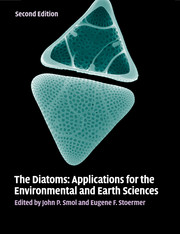Book contents
- Frontmatter
- Contents
- List of contributors
- Preface
- Part I Introduction
- Part II Diatoms as indicators of environmental change in flowing waters and lakes
- Part III Diatoms as indicators in Arctic, Antarctic, and alpine lacustrine environments
- Part IV Diatoms as indicators in marine and estuarine environments
- Part V Other applications
- 24 Diatoms of aerial habitats
- 25 Diatoms as indicators of environmental change in wetlands and peatlands
- 26 Tracking fish, seabirds, and wildlife population dynamics with diatoms and other limnological indicators
- 27 Diatoms and archeology
- 28 Diatoms in oil and gas exploration
- 29 Forensic science and diatoms
- 30 Toxic marine diatoms
- 31 Diatoms as markers of atmospheric transport
- 32 Diatoms as non-native species
- 33 Diatomite
- 34 Stable isotopes from diatom silica
- 35 Diatoms and nanotechnology: early history and imagined future as seen through patents
- Part VI Conclusions
- Glossary, acronyms, and abbreviations
- Index
- References
35 - Diatoms and nanotechnology: early history and imagined future as seen through patents
from Part V - Other applications
Published online by Cambridge University Press: 05 June 2012
- Frontmatter
- Contents
- List of contributors
- Preface
- Part I Introduction
- Part II Diatoms as indicators of environmental change in flowing waters and lakes
- Part III Diatoms as indicators in Arctic, Antarctic, and alpine lacustrine environments
- Part IV Diatoms as indicators in marine and estuarine environments
- Part V Other applications
- 24 Diatoms of aerial habitats
- 25 Diatoms as indicators of environmental change in wetlands and peatlands
- 26 Tracking fish, seabirds, and wildlife population dynamics with diatoms and other limnological indicators
- 27 Diatoms and archeology
- 28 Diatoms in oil and gas exploration
- 29 Forensic science and diatoms
- 30 Toxic marine diatoms
- 31 Diatoms as markers of atmospheric transport
- 32 Diatoms as non-native species
- 33 Diatomite
- 34 Stable isotopes from diatom silica
- 35 Diatoms and nanotechnology: early history and imagined future as seen through patents
- Part VI Conclusions
- Glossary, acronyms, and abbreviations
- Index
- References
Summary
History of diatom nanotechnology
As to form, the Diatoms present an infinite variety of size and outline. Mathematical curves of the most exquisite perfection, combinations which the designer would grasp with eagerness on the planning of his models, surfaces adorned with the most unlimited profusion of style and ornamentation, are everywhere presented
(Bailey, 1867).The origin of individual organization is one of those stubborn problems to which each generation of biologists has addressed itself anew
(Hall, 1969).Diatom nanotechnology started in 1863, when Max Schultze (Figure 35.1) noted that structures manufactured from silica vapor precipitating “in the form of minute spherules or lenticular particles” resembled diatoms (Schultze, 1863a, b) (Figure 35.2). He further showed “that neither in the artificial siliceous pellicles nor in the diatom valves are the peculiar forms due to a crystalline structure,” i.e. both consisted of amorphous silica. Schultze's controlled assembly at microscopic levels pre-dated the “father” of nanotechnology (Feynman, 1960), by almost 100 years. Schultze also did pioneering work on diatom motility, including discovery of the raphe (Schultze, 1858a, b, 1865; Goodale, 1885), but like most other diatomists until recently (Gordon et al., 2009), made his living in other fields, such as cytology, anatomy, histology, microscopy and vision, and is noted for clarifying the cell theory (Nordenskiöld, 1928; Hall, 1969; Werner et al., 1987; Nyhart, 1995; Brewer, 2006).
- Type
- Chapter
- Information
- The DiatomsApplications for the Environmental and Earth Sciences, pp. 590 - 608Publisher: Cambridge University PressPrint publication year: 2010
References
- 8
- Cited by



